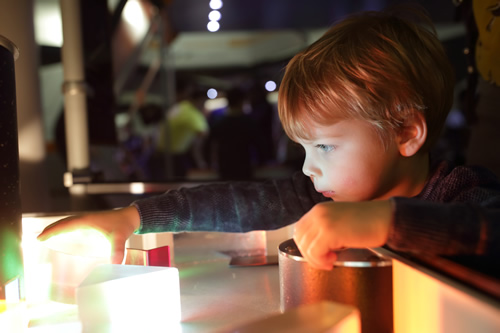Preparing young children for jobs that haven’t been invented yet may sound like a difficult task for educators, but a recent edWebinar showed how preK and kindergarten teachers can start developing the skills needed for future careers.
Marnie Forestieri, the CEO of Young Innovators, and Debby Mitchell, Ed.D., a Young Innovators curriculum writer, explained the process for creating lesson plans that include projects introducing science, technology, engineering, arts and math (STEAM), noting that “STEAM happens naturally in young children as they explore and investigate the world around them.”
Related content: Transitioning a school from STEM to STEAM
Among the skills that can be developed and enhanced in preK and kindergarten classes are four that have been identified as critical to the success of 21st century workers: creativity, communication, collaboration, and critical thinking. These can all be integrated into STEAM-related projects, along with other key skills such as analyzing information.
Creating an optimal STEAM lesson plan
Rather than teaching individual subjects in isolation as part of a STEAM project, Forestieri and Mitchell recommend integrating activities to optimize learning. This type of learning process is also aligned with real-world 21st century jobs, which are usually interdisciplinary and rarely require just one skill.
The way this can be done in a preK or kindergarten class is through a lesson plan and related project that includes all five STEAM elements:
Science: Studying the world around us
Technology: Using tools to learn and work
Engineering: Designing and building things
Arts: Making things attractive and engaging
Math: Measuring things and results
To accomplish all this, STEAM lesson plans need to start with a clear goal, such as acquiring knowledge about a specific scientific topic. The plan should then include vocabulary development, the preparation and use of any materials, step-by-step instructions, and guiding questions that will prompt young learners to investigate, forecast, and analyze results.
Implementing a STEAM lesson plan effectively
Especially for young students, one key aspect of the process is learning the related content-area vocabulary, which should be supported by clear definitions as well as the use of illustrations wherever possible. In addition, the teacher needs to model the use of everyday language related to the project, so students learn to “talk like engineers” rather than just learning what individual words mean.
Another important aspect is the use of questioning strategies by the teacher, so the students are encouraged to observe, discuss, predict, experiment, and reach evidence-based conclusions. Questions can also be used to prompt students to do research and find answers in books and videos, as well as on safe web sites.
Meanwhile, the students need to participate in hands-on activities and use their own senses as much as possible, in order to make the learning process engaging and meaningful. The introduction of STEAM careers should also be part of the lesson plan through play-based intentional experiences. This can include dress-up activities, and can be supplemented by field trips or classroom visits. Making careers known to young children in this way can stimulate their interest and provide direction for additional learning.
Throughout the process, the teacher should be documenting the learning that takes place, using handwritten notes, a computer or iPad, or photos or videos, as well as the students’ own work. This should include things such as forecasts and predictions, so the students and teacher can then compare the results to what was originally expected.
As the STEAM project reaches its conclusion, Forestieri and Mitchell recommend using music and movement to help celebrate what has been accomplished, because that can help students remember and integrate what they have learned. It also continues the process of integrating the arts into the project and turning STEM into STEAM.
About the presenters
Marnie Forestieri, BS and CDA, is the CEO and founder of Young Innovators. She has been a preschool teacher, director, writer and entrepreneur in the early childhood field. She is passionate about bringing solutions to the current challenges of the industry.
Dr. Debby Mitchell, EdD, is a curriculum writer for Young Innovators. She recently retired from teaching in the College of Education at University of Central Florida. Her doctorate is in physical education with a focus on early childhood. Her expertise and interests include: STEAM, brain research, developmentally appropriate movement activities and music, dance and rhythms, children’s wellness, obesity and integrating technology into the curriculum.
Join the community
Classroom Management for Early Learning is a free professional learning community on edWeb.net that helps early childhood educators share resources, tools, best practices and more to help them create healthy, creative and happy learning environments that support early learning and child development.
This broadcast was sponsored by Kaplan Early Learning Company. The recording of the edWebinar can be viewed by anyone here.
- The evolving requirements of a K-12 school network - April 24, 2024
- A bungled FAFSA rollout threatens students’ college ambitions - April 24, 2024
- How digital tools and AI can enhance social studies - April 23, 2024

